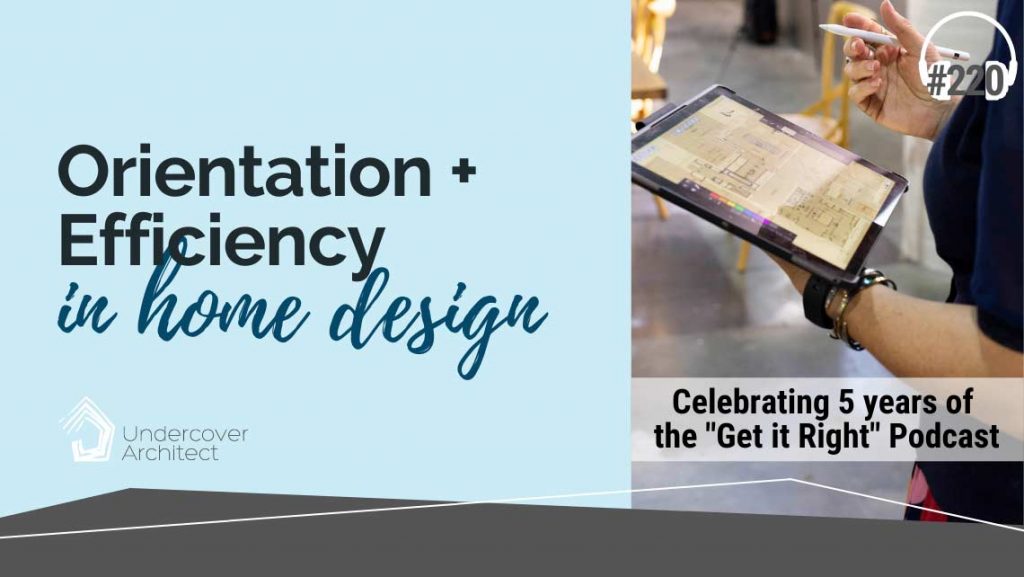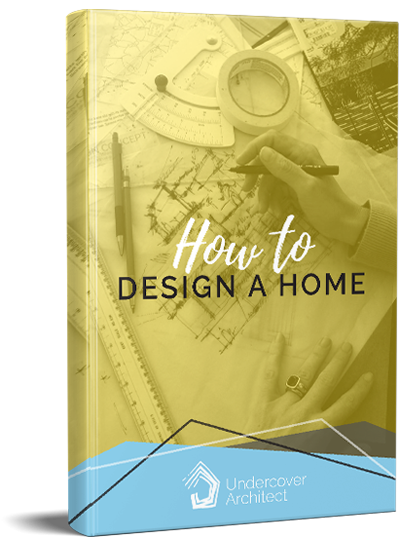
How do orientation and efficiency factor into your home design?
Are they the keys to a sustainable home and the best place to focus your efforts?
Learn more here.
Hello! This is Episode 220, and in it, I’m going to be providing an update to our last episode and continuing our celebration of 5 years of the “Get it Right” podcast.
Our last episode was a reboot of not only the most popular episode of Year 1 of the podcast – it’s also the most popular episode in the entire podcast’s 5 years.
If you haven’t listened to that episode, be sure you do so by heading back to Episode 219. You can find it, and its full downloadable PDF transcript by heading here: Still the most important thing to know when designing your home. That episode was called “Still the most important thing to know when designing your home”.
In this episode, I want to bring you some current information about the way we create homes, and how this can impact the things to know when designing your home, plus give you some ways to order your decisions.
This is the thing about designing, building and renovating. It involves a BOATLOAD of decisions, which can be overwhelming for many. And if you’re aiming for the perfect house, and think that making all the perfect decisions every step of the way will get you there, you may get really frustrated.
So this episode is going to help you simplify your home design decisions, and give you the ability to get clarity in your decision-making process.
So, the rebooted episode shared in our last episode was the first episode of Season 1.
If you haven’t listened to Season 1 in its entirety, I really encourage you to. In it, I take you through what you need to know about designing for orientation, understanding more about the natural assets of your site, and ways to create a home that works in a site-specific way.
And then it’s followed by Season 2, which takes you room by room through each space and room in your home. Those two seasons – Season 1 and Season 2 – are really great for getting you clear on the things that will matter in your home design decisions, and also help you to get started on thinking about how you want to live, and the way you can make that work on your specific site.
For the rest of Year 1 of the podcast, we then dived into Season 3, which was all about setting and sticking to your budget. The entire transcripts of that season are available as a chunky E-Book inside my mini-course “Set + Stick to Your Budget”, along with a raft of other great information including a workshop and a budget spreadsheet template.
And that was followed by Season 4, which was called “Know Your Team”, where I interviewed many of the different types of professionals you may need to use in your reno or new build project, including an architect, a building designer, a town planner, a structural engineer, a landscape architect, and the list goes on. If you’re curious about how different professionals work, what they do and how they help, it’s a great season to listen to before hiring your own project team.
The rebooted episode in our last podcast discussed the subject of orientation, and about knowing how the sun moves across your home and site so you can maximise the incredible benefits of natural light, whilst managing the heat of the sun according to the season to keep your home warm in Winter and cool in Summer.
I believe that doing this is the single biggest thing you can do to make your home feel great, and you feel great in it. And I also believe that it’s the single biggest thing you can do to create a sustainable home as well. When you’re utilising what is available for free, and optimising its ability to heat and cool your home naturally, it’s a really sustainable choice in lowering your energy use in your home overall.
Let’s talk about that energy use for a minute. You may have heard the terminology ‘net zero’ when it comes to homes. Net Zero homes are homes that produce the same amount of energy, through renewable energy sources such as solar power, as they consume in their occupant’s everyday use of the home.
For some sectors of the industry, this is the desired big push. This is seen as the way to significantly improve the impact our homes have on the climate and environment.
This is all shaped around the idea of this: How can I consider my home’s use of energy, and then supply that energy use with renewable energy sources, instead of relying on fossil fuels or gas to supply it?
This supply could be through your home’s own solar power, or through purchasing green power from your energy supplier.
Now, I said upfront that I was going to help you with ordering your decisions in your home design. And so, let’s jump into that now.
I do have a personal order or criteria for how I think about creating a sustainable home, and I like to keep it pretty simple
(Tune into the podcast or download the free PDF transcript to learn what it is).
It can, of course, be much more involved. Each of these things will have lots of layers. And the weight you put on specific things can also vary based on your own personal value judgements too.
This is how I often discuss it with homeowners who ask me “what should I focus on if I want to create a sustainable home?”
Listen to the episode now.
RESOURCES:
Year 1 Podcast Season:
Season 1 of the podcast (What Matters Most) >>> SEASON 1
Season 2 of the podcast (How to Design a Home) >>> SEASON 2
Season 3 of the podcast (Set + Stick to Your Budget) >>> SEASON 3
Season 4 of the podcast (Know Your Team) >>> SEASON 4
More helpful podcast episodes:
Season 8: A Simple Guide to a Sustainable Home >>> SEASON 8
Podcast Episode on dark roofs vs light roofs >>>
Other helpful resources:
Access the support and guidance you need to be confident and empowered when renovating and building your family home inside my flagship online program >>> HOME METHOD
Learn more about how to get started with your home design with the Happy Home Design mini-course >>> HAPPY HOME DESIGN
Check out how to set + stick to your budget with this mini-course >>> SET + STICK TO YOUR BUDGET
Access my free online workshop “Your Project Plan” >>> YOUR PROJECT PLAN
House Size (CommSec Report)
https://www.commbank.com.au/articles/newsroom/2020/11/commsec-home-size-trends-report.html
Water heat pumps
Energy Rating information on Heat Pump Hot Water Units >>> https://www.energyrating.gov.au/consumer-information/products/water-heating
Review use of heat water pumps based on podcast >>> http://www.cleanenergyregulator.gov.au/DocumentAssets/Pages/Postcode-zones-for-solar-water-heaters-and-heat-pumps.aspx
Zoned map for Solar Water heaters >>> https://www.energyrating.gov.au/sites/default/files/documents/E3-Zoned_Map_for_Solar_Water_Heaters_final_web_0.pdf
Victorian Energy Unit Product Registry (useful for all Australian locations) >>> http://www.veu-registry.vic.gov.au/public/productregistrysearch.aspx
Energy efficient appliances:
https://www.energy.gov.au/households/appliances (contains links to other sites as well)


 With over 30 years industry experience, Amelia Lee founded Undercover Architect in 2014 as an award-winning online resource to help and teach you how to get it right when designing, building or renovating your home. You are the key to unlocking what’s possible for your home. Undercover Architect is your secret ally
With over 30 years industry experience, Amelia Lee founded Undercover Architect in 2014 as an award-winning online resource to help and teach you how to get it right when designing, building or renovating your home. You are the key to unlocking what’s possible for your home. Undercover Architect is your secret ally
I love the idea of sufficiency. Looking at homes online, it’s sometimes hard to imagine a beautiful but small (not tiny!) home. It’s refreshing to hear you talk about reducing the footprint of our houses as a way of building more sustainably. Great ideas as always!